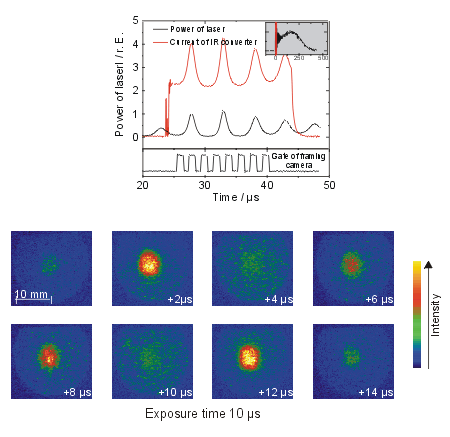
High-speed laser profiling
This experiment demonstrates the enormous temporal resolution of the IR converter. At these measurements the so called spiking of a single Nd:YAG laser pulse (wavelength 1.318 µm) is resolved in time and space. Therfore the IR converter is combined with a framing camera which allows to record 8 frames with a maximal frame rate of 3 Mfps (Million frames per second).
The laser pulse is projected to the input of the IR converter. A part of the beam is registered by a fast photodiode. The signal of the photodiode and the current flux of the IR converter is displayed on an oscilloscope (graphs of the following figure).

Figure of the
temporal behaviour of a Nd:YAG laser pulse.The
graph on the top shows the the incoming IR radiation and and the current
of the IR converter. The images are recorded by a framing camera system.
The graphs on the top show the temporal behaviour of the laser beam (red curve) and the current flux of the IR converter (black curve). The curve below is the trigger signal of the framing camera. The picture have an exposure time of 2 µs.
The laser pulse has a total length of about 300 µs (shown in the upper right plot). The images are taken between 25 and 45 µs of the laser pulse. On the graphs you can see the spiking of the laser pulse (black curve). The current of the IR converter represents this behaviour. Also the images show the spiking.
With the combination of the IR converter with a framing camera it is possible to register IR irradiation on a very short time scale.